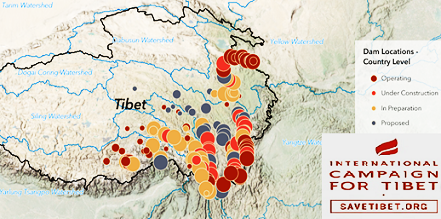 The People’s Republic of China’s (PRC) hydropower and dam projects are increasingly leading to massive human rights violations and environmental damage in Tibet. Since Asia’s largest rivers originate in the Tibetan plateau, the construction of hydroelectric dams in Tibet also threatens the water supply, livelihoods, and health of up to 1.8 billion people across China, South, and Southeast Asia.
The People’s Republic of China’s (PRC) hydropower and dam projects are increasingly leading to massive human rights violations and environmental damage in Tibet. Since Asia’s largest rivers originate in the Tibetan plateau, the construction of hydroelectric dams in Tibet also threatens the water supply, livelihoods, and health of up to 1.8 billion people across China, South, and Southeast Asia.
(...)
Recognition of Tibet as a source of natural resources, such as minerals and water, is not new. The People’s Republic of China’s more than 70-year occupation of Tibet continues to inflict gross human rights violations on the Tibetan people, often directly linked to the exploitation of Tibet’s natural environment. Thus, the most essential investment the PRC must take to right the wrongs of its decades of resource plunder is to enter meaningful dialogue with Tibetan leaders to reach a political solution that also includes the Tibetan people’s right to decide the use of their natural wealth and resources freely. The most politically marginalized communities should not pay the highest price for China’s ambitious hydropower plan.
Perhaps the most prominent example of the People’s Republic of China’s exploitation is its accelerating construction of hydropower dams along Tibet’s major rivers. The integrity of these rivers is fundamental to Tibet’s rich environment and its unique civilization. Also, up to 1.8 billion people throughout China, South, and Southeast Asia depend on their healthy flow for subsistence, health, and economic development. China’s rampant, command-and-control hydropower plans put all this at peril.
Until this report, the scope and scale of China’s single-minded push for ever more dams in Tibet has not been fully appreciated. The Chinese government has strategically obfuscated details of the hydropower expansion across Tibet because the plans attract justified concern and scrutiny from environmental experts, local communities, and downstream countries.
Utilizing rigorous in-region research and advanced GIS analysis and mapping, a sample study of 193 hydropower dams built or planned across Tibet since 2000, the analysis reveals the scale of hydropower expansion, as well as the impact each dam will have on local populations, religious sites, and surrounding land cover. In addition, an accompanying interactive map allows readers to explore individual dams, watersheds, and nearby settlements.

If completed, the 193 hydroelectric dams in the sample study would generate over 270 GW of hydropower. This is on par with Germany’s energy production capacity in 2022. Of the 193 dams studied, almost 80 per cent of dams are large or mega dams (>100MW), which carry the most significant risk to the Tibetan civilization, environmental sustainability, and the climate. Over half the dams (59%) are either in a proposal or preparation stage. This suggests that China’s ambitious hydropower energy plan is still a long-term project. Fortunately, it also indicates that hope remains to alter this destructive course.
Large-scale dams suffer from a slate of environmental harms, particularly in the locations proposed by China. Dams are both susceptible to and can cause an increased risk of earthquakes, landslides, and flash floods. They also cause environmental damage to vulnerable and biodiverse ecosystems by inundating land, reducing water quality and flow, and interrupting aquatic life. Dams also block soil, water, and nutrient flows, which are essential for supporting life in downstream countries ...
[ Full report ]
Comments powered by CComment